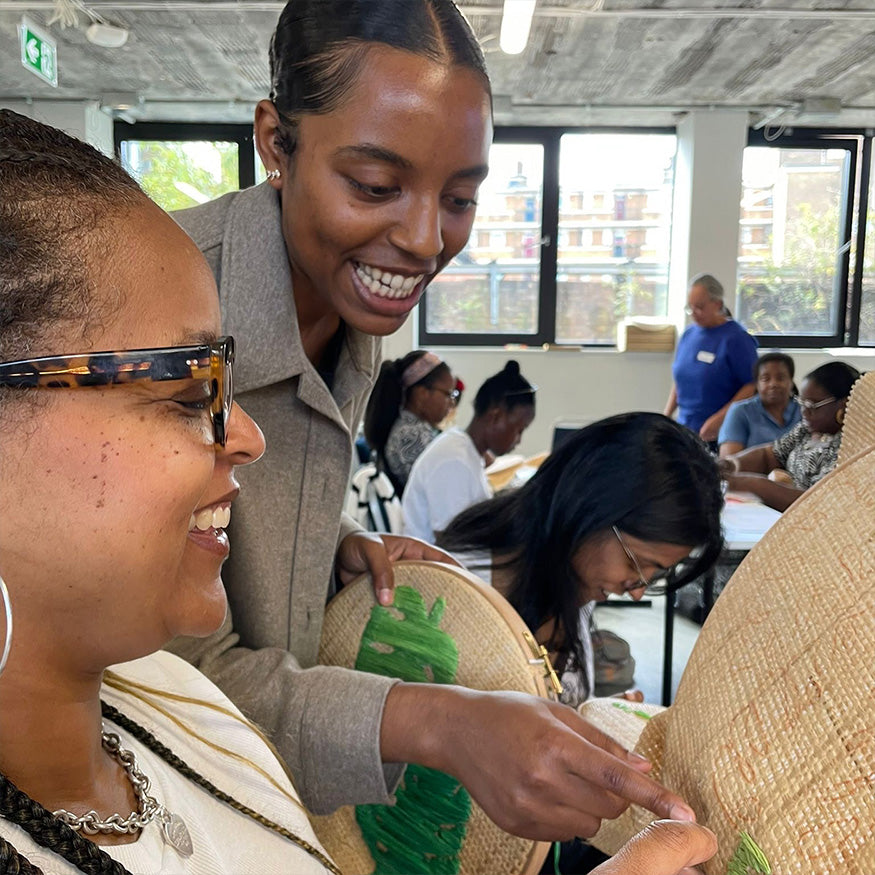Get 10% off with code:

WHAT IS AN INDEPENDENCE DAY?
An Independence Day is an annual event where a nation celebrates its independence from another country or state. For the Caribbean region, this is typically from European powers. Celebrations can include nationwide events such as festivals, street dances, concerts, parades, fireworks, and cultural performances that showcase the unique heritage of the country. People often wear clothing and accessories featuring the nation’s flag or traditional dress. Caribbean diaspora communities worldwide will celebrate, showcasing the nation's flag, enjoying traditional foods, and participating in celebratory events.
A BRIEF HISTORY OF THE CARIBBEAN - FROM COLONY TO INDEPENDENT
The Caribbean region was colonised by European nations in the 17th & 18th centuries. Using enslaved African labour, they introduced a plantation economy to the region, mainly based on sugar but also rum, cotton, coffee and cocoa. Most Caribbean countries were under colonial rule even after the abolition of slavery. However, it must be noted that Haiti, a former French colony, was the first Caribbean nation to gain independence from a European power in 1803, even before the French abolition of slavery. This was after what is known as the largest and most successful slave rebellion in the Western Hemisphere from 1791 to 1803 (see the links at the end of this post to learn more about it). This is not to say enslaved people from other Caribbean nations did not revolt; there were constant revolts until emancipation in 1834 including in 1760s Jamaica, 1790s Grenada and 1810s Barbados.

The British slave trade officially ended in 1807, so the buying and selling of African people was made illegal. Slavery itself ended in the British Caribbean on 1 August 1834. After this date, a period of apprenticeship was introduced on some Caribbean islands where previously enslaved people were forced to work as apprentices for their old masters, so it can be argued that enslavement did not end until 1838 when the apprenticeship system ended. Even after this time, life was hard for previously enslaved people as they received no compensation, and their interests weren’t represented in the law. Indentured labourers from China and India were brought to the Caribbean region after slavery to fill in the labour void on plantations. The indentured labour system was grossly abused, and labourers were forced to endure long working days, heavy workloads and poor housing. This system was not abolished until the early 20th century. After this, people of African, Indian, and Chinese descent continued to struggle to own land and build their communities.
In the earlier part of the 20th century, some Caribbean people served with the British armed forces with other members of the British Empire in the First World War. At first, volunteers were rejected by the British authorities but as the war continued, the authorities began to accept them but gave them menial jobs. Caribbean men and women also responded to calls from Britain in the Second World War as many felt they had a patriotic duty to the ‘Mother Country’.
In 1958, after the end of WW2, several of the British-controlled Caribbean territories were joined in the West Indies Federation to create political unity. The territories that were part of the West Indies Federation included:
- Barbados
- Dominica
- Grenada
- Jamaica
- Montserrat
- Saint Lucia
- Trinidad and Tobago
- St Vincent
- Antigua and Barbud
- St-Kitts-Nevis-Anguilla (also known as Saint Christopher-Nevis-Anguilla)
During its brief existence, between 1958 and 1962, the federation faced many problems. The territories disagreed over the structure of the federation, and specific policies and many of the territories were unwilling to give up control to the Federal Government.

The West Indies Federation collapsed in 1962. This was after Jamaica, the largest member, decided to leave the federation after a national referendum. This led to a movement for full independence from Britain, which Jamaica achieved in 1962. Trinidad and Tobago also gained independence that same year.
Other Caribbean islands followed, gradually achieving their independence in the years that followed. St. Kitts and Nevis were the last to gain independence in 1983.
Today, some Caribbean islands, including:
- Anguilla
- The British Virgin Islands
- The Cayman Islands
-
Montserrat
The Turks and Caicos Islands
These all maintain their status as British Overseas Territories.
LIST OF CARIBBEAN INDEPENDENCE DAYS
This is an alphabetical list of Caribbean countries that gained independence from British colonial rule.
Antigua & Barbuda 🇦🇬
1st November 1981
Antigua and Barbuda Independence Day is celebrated on November 1 each year. Antigua and Barbuda gained independence on 1 November 1981, after more than 350 years of British rule.

The Bahamas 🇧🇸
10th July 1973
Bahamian Independence Day is celebrated on July 10 each year. The Bahamas became a free and sovereign country on 10 July 1973, ending around 325 years of British rule.

Barbados 🇧🇧
30th November 1966
November 30 is the date of Barbados Independence Day, a national holiday in Barbados. It celebrates the nation achieving independence from Britain on 30 November 1966.

Belize 🇧🇿
21st September 1981
Belize Independence Day is celebrated on September 21 each year. While Belize is geographically located in Central America, it's often considered a Caribbean country. This is because its eastern coastline borders the Caribbean Sea, and its history closely resembles that of Caribbean islands, having been under British rule for over two centuries. Belize gained independence on September 21, 1981.

Dominica 🇩🇲
3rd November 1978
Dominica Independence Day is celebrated on November 3 each year. Dominica gained independence on 3 November 1978 as a republic within the Commonwealth. It is officially known as the Commonwealth of Dominica.

Grenada 🇬🇩
7th February 1974
Grenada became fully independent on 7 February 1974. An interesting fact about Grenada’s Independence Day is that it was celebrated by candlelight as employees of the local electricity company were on strike.

Guyana 🇬🇾
26th May 1966
Guyana Independence Day is celebrated on May 26 each year. Although geographically part of South America, Guyana is often considered a Caribbean country. This is because it shares strong cultural and political connections with other Caribbean nations. Formerly known as British Guiana, Guyana achieved independence on May 26, 1966.

Jamaica 🇯🇲
6th August 1962
Jamaica Independence Day is celebrated on August 6 each year. Jamaica was the first country to withdraw from the West Indies Federation. On August 6, 1962, Jamaica gained independence. This day is now a national holiday in Jamaica. During the independence celebrations, the British Union Jack was lowered, and the Jamaican flag was raised across the country. The Cayman Islands, which was once a dependent of Jamaica, returned to British rule following Jamaica's independence.

St Kitts & Nevis 🇰🇳
19th September 1983
St-Kitts-Nevis-Anguilla (also known as Saint Christopher-Nevis-Anguilla) was a British colony from around 1882 to 1983. It included the islands Nevis, St Kitts (St Christopher) and the island of Anguilla until 1980. St Kitts and Nevis gained independence on 19 September 1983, whilst Anguilla remains a British Overseas Territory. St Kitts and Nevis Independence Day is celebrated on September 19 each year.

St Lucia 🇱🇨
22nd February 1979
The island of St. Lucia has been much fought over, particularly between the French and British. However, on February 22, 1979, St. Lucia gained independence from Britain. St Lucia Independence Day is now a national holiday in St Lucia.

St Vincent & The Grenadines 🇻🇨
27th October 1979
After the collapse of the West Indies Federation, some Eastern Caribbean nations attempted to set up a smaller federation, but this was unsuccessful. Following a referendum, St Vincent and the Grenadines became the last Windward Island to gain independence on 27 October 1979. St Vincent and the Grenadines Independence Day is celebrated on October 27 each year.

Trinidad & Tobago 🇹🇹
31st August 1962
The Trinidad and Tobago flag was raised for the first time on 31 August 1962 as they gained independence from Britain. Across the country, independence was celebrated with more than a week of festivities. Trinidad and Tobago Independence Day is celebrated on August 31 each year.

Greeting Cards Inspired by the Caribbean & Perfect for an independence day
Add a special touch to your Caribbean Independence Day celebrations by sending someone a special greeting card featuring beautiful illustrations inspired by their heritage! We offer a selection of greeting cards (and art prints) celebrating various Caribbean countries.
Each card includes beautiful artwork that captures an aspect of the country to celebrate its independence day.
Did you know?
For each Independence Day, you could gift friends a greeting card featuring a short fact about that island.
These make an ideal Independence Day gift for anyone celebrating the occasion or keen to learn more about the island.
Caribbean Independence Days in date Order
Find the independence day you are looking for below:
7th February 1974 - Grenada
22nd February 1979 - St Lucia
26th May 1966 - Guyana
10th July 1973 - The Bahamas
6th August 1962 - Jamaica
31st August 1962 - Trinidad & Tobago
19th September 1983 - St Kitts & Nevis
21st September 1981 - Belize
27th October 1979 - St Vincent & The Grenadines
1st November 1981 - Antigua & Barbuda
3rd November 1978 - Dominica
30th November 1966 - Barbados
Caribbean Independence Day - FAQs
What is Caribbean Independence Day and why is it important?
A Caribbean Independence Day marks the anniversaries of when individual Caribbean nations became politically independent, mainly from British colonial rule. These Independence Days are observed on different dates throughout the year, with many taking place between June and November.
Which was the first Caribbean country to gain independence?
Haiti was the first Caribbean nation and the first Black republic in the world to gain independence on January 1, 1804, after a successful revolution against French colonial rule. This indepence day is celebrated by many outside of Haiti and is a symbol of their strength and resillience
Why do Caribbean Independence Days matter today?
An Independence Day remains important because they reflect national sovereignty, self-governance, and cultural confidence. Across the region, each Independence Day provides opportunities to reflect on historical struggles while reinforcing modern national identity.
How did the process of independence differ among Caribbean nations?
Independence came through different paths. Some through peaceful negotiations with Britain, others through revolutions or referendums. The timeline also varies widely, from Haiti in 1804 to Saint Kitts and Nevis in 1983.
You can find an independence day for all Caribbean islands on our list
How do Caribbean countries celebrate their Independence Days?
Independence day celebrations often include parades, flag-raising ceremonies, cultural performances, fireworks, and music festivals. Each country adds its unique local traditions to the festivities.
How are Caribbean Independence Days linked to colonial history?
Caribbean Independence Days are directly connected to the end of European colonial administration. Mostly, an Independence Day is to commemorate the transfer of political power from colonial governments to locally elected leadership.
What role did independence movements play in shaping Caribbean identity?
Independence movements laid the foundation for modern Caribbean societies. The values promoted during these movements continue to influence how Independence Days are observed, particularly through education, cultural expression, and national symbolism.
Are Caribbean Independence Days public holidays?
Yes, on an independence day most Caribbean islands recognised it as a public holiday. Schools, government offices, and many businesses close on an independence day to allow citizens to participate in official events and community celebrations.
How do schools and communities mark Independence Days in the Caribbean?
Schools and community groups often organise assemblies, cultural performances, and history lessons linked to Independence Days. These activities help younger generations understand the significance of independence and national development.
What symbols and traditions are commonly associated with Caribbean Independence Days?
On an Independence Day flags, national anthems, and official mottos play a central role. Also on an Independence Day. Traditional dress, music, and historical reenactments are also commonly featured as part of the celebrations.
How have Caribbean Independence Days changed over time?
Over time, Independence Days have evolved from formal political ceremonies into broader cultural events. Many countries now use an Independence Day to highlight creativity, heritage, and social progress alongside historical reflection.
What food, music, and cultural practices are highlighted during Independence Days celebrations?
Local cuisine, traditional music, and national art forms are often showcased during an Independence Day. These elements reinforce cultural continuity and allow Independence Days to serve as living expressions of national culture.
What is the significance of flag-raising ceremonies on Independence Days?
On Independence Day, flag-raising ceremonies symbolise sovereignty and national pride. These ceremonies serve as formal reminders of political autonomy and shared national values.
How do diaspora communities observe Caribbean Independence Days abroad?
Diaspora communities frequently mark the Independence Day through cultural events, educational programmes, and community gatherings. These observances help maintain connections to national heritage beyond the Caribbean.
What can you do to celebrate an Independence Day where you live?
You can celebrate an Independence Day where you live by taking part in local events that reflect national history and community spirit. Many people choose to attend official ceremonies, watch parades, or visit cultural exhibitions that explain the meaning of independence.
An Independence Day can also be marked in more personal ways, such as displaying the national flag, learning about the country’s path to independence, or preparing traditional food at home. Supporting local artists, musicians, or community organisations is another way to engage with an Independence Day while strengthening a sense of shared identity.
Do you run workshops or events that can help celebrate a Caribbean Indepence Day??
Yes. I run raffia embroidery workshops, take part in panel discussions, particpate in event market stalls and can provide products for client gifting. In my sessions I can help the audience explore heritage, storytelling, and creative expression linked to the Caribbean craft.
My services are suitable for community groups, organisations, and educational settings. Anyone interested in booking or finding out more can contact me at hello@tiharasmith.com or check out this page for more information.
Independence Day Sources & Further Reading
- The West Indies Federation - Read more
- Haitian Revolution - Read more
- Let’s stop erasing the history of Caribbean indentured labour - Read more
- Caribbean Histories Revealed - Read more
- How did the heroes of the Caribbean help win the war? - Read more
- Independence in the Caribbean - Read more
- Images from Unsplash - S Kelly, Anita Denunzio & Phil Hauser
Stay Connected ☀️
Sign up for our newsletter and get curated stories and discoveries celebrating Caribbean culture and the diaspora delivered straight to your inbox, plus enjoy a 10% discount on your first order! Don't miss out - subscribe below ✨










